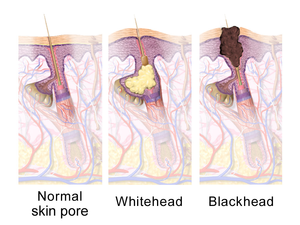痤疮
| 痤瘡 | |
|---|---|
| 同义词 | 尋常性痤瘡 又稱青春痘 |
 | |
| 一名18歲青春期男性的尋常性痤瘡 | |
| 症状 | 黑頭、白頭、疙瘩、油性皮膚、留疤[1][2] |
| 併發症 | 焦慮[3][4] |
| 起病年龄 | 青春期[5] |
| 类型 | sebaceous gland disease[*]、疾病 |
| 风险因素 | 遺傳學[2] |
| 鑑別診斷 | 毛囊炎、酒槽鼻、化膿性汗腺炎、痱子[6] |
| 治療 | 改變生活方式、藥物、醫療程序[7][8] |
| 藥物 | 壬二酸、過氧化苯甲酰、水楊酸、抗生素、口服避孕藥、異維A酸[8] |
| 患病率 | 6.33亿(2015)[9] |
| 分类和外部资源 | |
| 醫學專科 | 皮膚病學 |
| ICD-11 | ED80 |
| ICD-10 | L70 |
| ICD-9-CM | 706.0 |
| OMIM | 604324 |
| DiseasesDB | 10765 |
| MedlinePlus | 000873 |
| eMedicine | 1069804 |
| 痤瘡 | |
|---|---|
| 注音符號 | ㄘㄨㄛˊ ㄔㄨㄤ |
| 漢語拼音 | cuó chuāng |
痤瘡(英語:acne、拼音:cuó chuāng、注音:ㄘㄨㄛˊ ㄔㄨㄤ);也称为尋常性痤瘡(拉丁語:acne vulgaris)、青春痘,俗稱痘痘,在毛囊被死皮细胞和来自皮膚的油脂堵塞時出现。[11] 它的特点是黑頭或白頭、疙瘩、油性皮膚,可能會有疤痕[1][2][12] 它主要影響皮脂腺數量相對较多的皮膚部位,包括臉部、胸部上部和背部。[13] 。[3][4]
80%的病例中認为遺傳因素是主要病因。[2] 飲食和吸菸的作用尚不清楚,皮膚是否乾淨、是否暴露在陽光下与痤瘡的形成無關。[2][14][15] 在青春期,痤瘡通常都是由睪固酮的增加引起。[5] 一般出现在皮膚上的痤瘡丙酸桿菌(Propionibacterium acnes)是常見病因。[5]
痤瘡有许多治療方法可供选择,包括改變生活方式、藥物和醫療程序。少吃食糖等單醣可能會對病情有所帮助。[7] 外敷壬二酸、过氧化苯甲酰和水楊酸是常用的治疗手段。[8] 抗生素和維生素A酸可用於口服治療痤疮。[8]
然而,抗生素治疗可能會對抗生素產生耐藥性。[16] 若干种避孕药对女性的痤疮有治療效果。[8] 由於口服維生素A酸會有較大的副作用,因此只建議嚴重的痤瘡患者使用。[8] 醫療界的一些人士倡導儘早積極地治療,以減輕痤瘡對患者的長遠影響。[4]
據估計,2015年,痤瘡在全球范围内影响6.33亿人,成為了全球第八大常见疾病。[9][17] 痤瘡常發生於青少年時期,约80–90%西方世界的青少年患有痤瘡。[18][19][20] 在乡下患痤瘡的比例則較低。[20][21] 兒童和成人在青春期前后都有可能患病。[22] 雖然成人罹患痤瘡不太常见,但患者中近半數直至20歲或30歲都還持續發生痤瘡,有一少部分人甚至到40歲都還為此感到困擾。[2]
形成原因
一般痤瘡的形成,有以下幾個因素,但最終原因都是皮脂分泌過多和堵塞引起的
- 皮脂腺發達:排出過多皮脂,油脂腺發達的人不容易肥胖但更容易得粉刺
- 饮食:虽然大众常认为多油脂和刺激性的食物容易引发痤疮,但目前没有证据可以确定两者之间的关联。[23]
- 內分泌失調:內分泌失調使得皮脂分泌過多,此與睡眠,休息,壓力和情緒有關
- 毛囊角質化(Follicular hyperkeratinization):毛囊角質化導致皮脂腺的分泌物無法排出,進而導致毛囊破裂,發炎細胞浸潤(inflammatory cells infiltration)
- 皮脂腺過度分泌:過多的雄性或䧳性激素(Androgen)導致皮脂腺分泌過分旺盛。此與個人先天體質、後天環境有關。
- 痤瘡丙酸桿菌孳生(Propionibacterium acnes proliferation and colonization):痤瘡丙酸桿菌將皮脂固化,促進發炎反應
- 發炎物質(inflammatory mediators)的釋出:痤瘡丙酸桿菌分解皮脂腺分泌的三酸甘油脂成脂肪酸,促進了發炎反應
症状

表现
- 毛囊分泌過多油脂。
- 黑頭白頭:兩者都是非炎性的,由皮脂過多引起。前者由於存在开口,表面油脂被空氣氧化而呈黑色;後者没有开口,故皮脂保持白色
- 丘疹
- 结節
後遗症
- 疤痕:凹陷,溝痕,水痘样
- 色素沉淀
治療方法
治療藥物
治療藥物一般有外用與口服兩種劑型
外用劑型
口服劑型
療程視病患嚴重程度,從4週到半年以上不等。各類處方藥需遵照醫囑使用。
抗生素療法
以抗生素來殺死皮脂腺中的痤瘡丙酸桿菌,使其無法分解三酸甘油脂成脂肪酸,進而減少發炎反應。第一線通常使用四環素類抗生素(例如:四環黴素, 去氧羥四環素, 米諾環素),如產生抗藥性則使用第二線克林黴素(Clindamycin)類,再有抗藥性則使用第三線磺胺(Baktar)類藥物。
激素療法
適用於以成年女性為主的亞型。通常使用螺內酯(Spironolactone)類利尿劑、口服避孕藥以調整體內失調的激素。
异维A酸
异维A酸(Isotretinoin)可以促使皮脂腺萎縮,從最根本治療痤疮。並且有殺菌、抗發炎等效果。不過皮脂腺萎縮屬於不可逆的過程,故雖然效果最強,但屬最後一線療法,非不得已不輕易使用。
病灶内糖皮质激素
將病灶内糖皮质激素(Intralesional Glucocorticoids,俗稱「痘痘針」),屬於類固醇類藥物。直接注射病灶處,可以快速緩解患處的發炎反應。
参考文献
- ^ 1.0 1.1 Vary, JC, Jr. Selected Disorders of Skin Appendages — Acne, Alopecia, Hyperhidrosis. The Medical Clinics of North America (Review). November 2015, 99 (6): 1195–1211. PMID 26476248. doi:10.1016/j.mcna.2015.07.003.
- ^ 2.0 2.1 2.2 2.3 2.4 2.5 Bhate, K; Williams, HC. Epidemiology of acne vulgaris. The British Journal of Dermatology (Review). March 2013, 168 (3): 474–85. PMID 23210645. doi:10.1111/bjd.12149.
- ^ 3.0 3.1 Barnes, LE; Levender, MM; Fleischer, AB, Jr.; Feldman, SR. Quality of life measures for acne patients. Dermatologic Clinics (Review). April 2012, 30 (2): 293–300. PMID 22284143. doi:10.1016/j.det.2011.11.001.
- ^ 4.0 4.1 4.2 Goodman, G. Acne and acne scarring–the case for active and early intervention. Australian family physician (Review). July 2006, 35 (7): 503–4 [2015-04-05]. PMID 16820822. (原始内容存档于2013-04-21).
- ^ 5.0 5.1 5.2 James, WD. Acne. New England Journal of Medicine (Review). April 2005, 352 (14): 1463–72. PMID 15814882. doi:10.1056/NEJMcp033487.
- ^ Kahan, Scott. In a Page: Medicine. Lippincott Williams & Wilkins. 2008: 412 [2017-06-15]. ISBN 9780781770354. (原始内容存档于2017-12-14) (英语).
- ^ 7.0 7.1 Mahmood, SN; Bowe, WP. Diet and acne update: carbohydrates emerge as the main culprit. Journal of Drugs in Dermatology: JDD (Review). April 2014, 13 (4): 428–35. PMID 24719062.
- ^ 8.0 8.1 8.2 8.3 8.4 8.5 Titus, S; Hodge, J. Diagnosis and treatment of acne. American Family Physician (Review). October 2012, 86 (8): 734–40 [2015-04-05]. PMID 23062156. (原始内容存档于2015-02-18).
- ^ 9.0 9.1 GBD 2015 Disease and Injury Incidence and Prevalence, Collaborators. Global, regional, and national incidence, prevalence, and years lived with disability for 310 diseases and injuries, 1990-2015: a systematic analysis for the Global Burden of Disease Study 2015.. Lancet. 8 October 2016, 388 (10053): 1545–1602. PMID 27733282.
- ^ 教育部國語辭典簡編本. dict.concised.moe.edu.tw. [2019-12-08]. (原始内容存档于2019-12-10).
- ^ Aslam, I; Fleischer, A; Feldman, S. Emerging drugs for the treatment of acne. Expert Opinion on Emerging Drugs (Review). March 2015, 20 (1): 91–101. PMID 25474485. doi:10.1517/14728214.2015.990373.

- ^ Tuchayi, SM; Makrantonaki, E; Ganceviciene, R; Dessinioti, C; Feldman, SR; Zouboulis, CC. Acne vulgaris. Nature Reviews Disease Primers. September 2015: 15033. doi:10.1038/nrdp.2015.33.
- ^ Frequently Asked Questions: Acne (PDF). U.S. Department of Health and Human Services, Office of Public Health and Science, Office on Women's Health. July 2009 [30 July 2009]. (原始内容存档 (PDF)于2016-12-10).
- ^ Knutsen-Larson, S; Dawson, AL; Dunnick, CA; Dellavalle, RP. Acne vulgaris: pathogenesis, treatment, and needs assessment. Dermatologic Clinics (Review). January 2012, 30 (1): 99–106. PMID 22117871. doi:10.1016/j.det.2011.09.001.
- ^ Schnopp, C; Mempel, M. Acne vulgaris in children and adolescents. Minerva Pediatrica (Review). August 2011, 63 (4): 293–304. PMID 21909065.
- ^ Beylot, C; Auffret, N; Poli, F; Claudel, JP; Leccia, MT; Del Giudice, P; Dreno, B. Propionibacterium acnes: an update on its role in the pathogenesis of acne. Journal of the European Academy of Dermatology and Venereology: JEADV (Review). March 2014, 28 (3): 271–8. PMID 23905540. doi:10.1111/jdv.12224.
- ^ Hay, RJ; Johns, NE; Williams, HC; Bolliger, IW; Dellavalle, RP; Margolis, DJ; Marks, R; Naldi, L; Weinstock, MA; Wulf, SK; Michaud, C; Murray, C; Naghavi, M. The Global Burden of Skin Disease in 2010: An Analysis of the Prevalence and Impact of Skin Conditions. The Journal of Investigative Dermatology. October 2013, 134 (6): 1527–34. PMID 24166134. doi:10.1038/jid.2013.446.
- ^ Taylor, M; Gonzalez, M; Porter, R. Pathways to inflammation: acne pathophysiology. European Journal of Dermatology (Review). May–June 2011, 21 (3): 323–33. PMID 21609898. doi:10.1684/ejd.2011.1357.
- ^ Dawson, AL; Dellavalle, RP. Acne vulgaris. BMJ (Review). May 2013, 346 (5): f2634. JSTOR 23494950. PMID 23657180. doi:10.1136/bmj.f2634.
- ^ 20.0 20.1 Goldberg, DJ; Berlin, AL. Acne and Rosacea: Epidemiology, Diagnosis and Treatment. London: Manson Pub. October 2011: 8 [2017-06-15]. ISBN 978-1-84076-150-4. (原始内容存档于2016-12-23).
- ^ Spencer, EH; Ferdowsian, BND. Diet and acne: a review of the evidence. International Journal of Dermatology (Review). April 2009, 48 (4): 339–47. PMID 19335417. doi:10.1111/j.1365-4632.2009.04002.x.
- ^ Admani, S; Barrio, VR. Evaluation and treatment of acne from infancy to preadolescence. Dermatologic Therapy (Review). November 2013, 26 (6): 462–6. PMID 24552409. doi:10.1111/dth.12108.
- ^ Hui, RexWH. Common misconceptions about acne vulgaris: A review of the literature. Clinical Dermatology Review. 2017, 1 (2): 33 [2020-09-15]. ISSN 2542-551X. doi:10.4103/CDR.CDR_16_17. (原始内容存档于2018-06-02) (英语).
